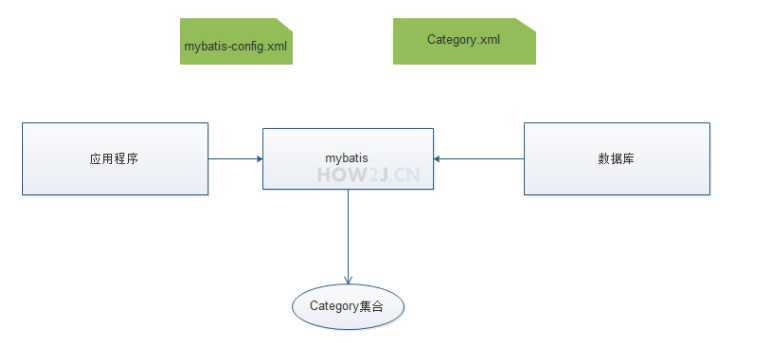7.2 Mybatis
Posted smileing
tags:
篇首语:本文由小常识网(cha138.com)小编为大家整理,主要介绍了7.2 Mybatis相关的知识,希望对你有一定的参考价值。
7.2 Mybatis
平时我们都用JDBC访问数据库,除了需要自己写SQL之外,还必须操作Connection, Statement, ResultSet 这些其实只是手段的辅助类。 不仅如此,访问不同的表,还会写很多雷同的代码,显得繁琐和枯燥。
那么用了Mybatis之后,只需要自己提供SQL语句,其他的工作,诸如建立连接,Statement, JDBC相关异常处理等等都交给Mybatis去做了,那些重复性的工作Mybatis也给做掉了,我们只需要关注在增删改查等操作层面上,而把技术细节都封装在了我们看不见的地方。
在src目录下创建mybatis的主配置文件mybatis-config.xml (相当于hibernate.cfg.xml)
1. 应用程序找Mybatis要数据
public static void main(String[] args) throws IOException String resource = "mybatis-config.xml"; InputStream inputStream = Resources.getResourceAsStream(resource); SqlSessionFactory sqlSessionFactory = new SqlSessionFactoryBuilder().build(inputStream); SqlSession session=sqlSessionFactory.openSession(); List<Category> cs=session.selectList("listCategory"); for (Category c : cs) System.out.println(c.getName());
2. mybatis从数据库中找来数据
2.1 通过mybatis-config.xml 定位哪个数据库
<?xml version="1.0" encoding="UTF-8" ?> <!DOCTYPE configuration PUBLIC "-//mybatis.org//DTD Config 3.0//EN" "http://mybatis.org/dtd/mybatis-3-config.dtd"> <configuration> <typeAliases> <package name="com.how2java.pojo"/> </typeAliases> <environments default="development"> <environment id="development"> <transactionManager type="JDBC"/> <dataSource type="POOLED"> <property name="driver" value="com.mysql.jdbc.Driver"/> <property name="url" value="jdbc:mysql://localhost:3306/how2java?characterEncoding=UTF-8"/> <property name="username" value="root"/> <property name="password" value="admin"/> </dataSource> </environment> </environments> <mappers> <mapper resource="com/how2java/pojo/Category.xml"/> </mappers> </configuration>
2.2 通过Category.xml执行对应的select语句
<?xml version="1.0" encoding="UTF-8"?> <!DOCTYPE mapper PUBLIC "-//mybatis.org//DTD Mapper 3.0//EN" "http://mybatis.org/dtd/mybatis-3-mapper.dtd"> <mapper namespace="com.how2java.pojo"> <select id="listCategory" resultType="Category"> select * from category_ </select> </mapper>
2.3 基于Category.xml把返回的数据库记录封装在Category对象中
2.4 把多个Category对象装在一个Category集合中
2.5 返回一个Category集合

3.mappper里的增删改查。
其中mappper中的标签对应Dao层的调用方法。在运行项目中,如果id对用不上。或者重复,会报注入bean错误
parameterType表示需要注入的实体或者类型
resultType表示为查询或者调用SQL返回的实体类型
<?xml version="1.0" encoding="UTF-8"?> <!DOCTYPE mapper PUBLIC "-//mybatis.org//DTD Mapper 3.0//EN" "http://mybatis.org/dtd/mybatis-3-mapper.dtd"> <mapper namespace="com.how2java.pojo"> <insert id="addCategory" parameterType="Category" > insert into category_ ( name ) values (#name) </insert> <delete id="deleteCategory" parameterType="Category" > delete from category_ where id= #id </delete> <select id="getCategory" parameterType="_int" resultType="Category"> select * from category_ where id= #id </select> <update id="updateCategory" parameterType="Category" > update category_ set name=#name where id=#id </update> <select id="listCategory" resultType="Category"> select * from category_ </select> </mapper>
3.1模糊查询
mysql:select * from category_ where name like concat(‘%‘,#0,‘%‘)
oracle:select * from category_ where name like ‘%‘||#0||‘%‘
3.2多条件查询
在dao层多个@parm参数,然后根据入参map多个条件查询
<select id="listCategoryByIdAndName" parameterType="map" resultType="Category"> select * from category_ where id> #id and name like concat(‘%‘,#name,‘%‘) </select> <select id="listProduct" resultType="Product"> select * from product_ <if test="name!=null"> where name like concat(‘%‘,#name,‘%‘) </if> </select>
4.2 where 标签
通常有多个条件时使用
<select id="listProduct" resultType="Product"> select * from product_ <where> <if test="name!=null"> and name like concat(‘%‘,#name,‘%‘) </if> <if test="price!=null and price!=0"> and price > #price </if> </where> </select>
4.3 set标签;与where标签类似的,在update语句里也会碰到多个字段相关的问题。 在这种情况下,就可以使用set标签:
<update id="updateProduct" parameterType="Product" > update product_ <set> <if test="name != null">name=#name,</if> <if test="price != null">price=#price</if> </set> where id=#id </update>
4.4trim 用来定制想要的功能,比如where标签就可以用,来替换
运行set标签中的代码,其效果是一样的。
<select id="listProduct" resultType="Product"> select * from product_ <trim prefix="WHERE" prefixOverrides="AND |OR "> <if test="name!=null"> and name like concat(‘%‘,#name,‘%‘) </if> <if test="price!=null and price!=0"> and price > #price </if> </trim> </select> <update id="updateProduct" parameterType="Product" > update product_ <trim prefix="SET" suffixOverrides=","> <if test="name != null">name=#name,</if> <if test="price != null">price=#price</if> </trim> where id=#id </update>
4.5 Mybatis里面没有else标签,但是可以使用when otherwise标签来达到这样的效果。
<select id="listProduct" resultType="Product"> SELECT * FROM product_ <where> <choose> <when test="name != null"> and name like concat(‘%‘,#name,‘%‘) </when> <when test="price !=null and price != 0"> and price > #price </when> <otherwise> and id >1 </otherwise> </choose> </where> </select>
4.6 foreach标签,相当于运行的查询条件是一个集合,用in条件。
<select id="listProduct" resultType="Product"> SELECT * FROM product_ WHERE ID in <foreach item="item" index="index" collection="list" open="(" separator="," close=")"> #item </foreach> </select>
4.7 bind标签,bind标签就像是再做一次字符串拼接,方便后续使用
<!-- 本来的模糊查询方式 --> <!-- <select id="listProduct" resultType="Product"> --> <!-- select * from product_ where name like concat(‘%‘,#0,‘%‘) --> <!-- </select> --> <select id="listProduct" resultType="Product"> <bind name="likename" value="‘%‘ + name + ‘%‘" /> select * from product_ where name like #likename </select>
以上是关于7.2 Mybatis的主要内容,如果未能解决你的问题,请参考以下文章